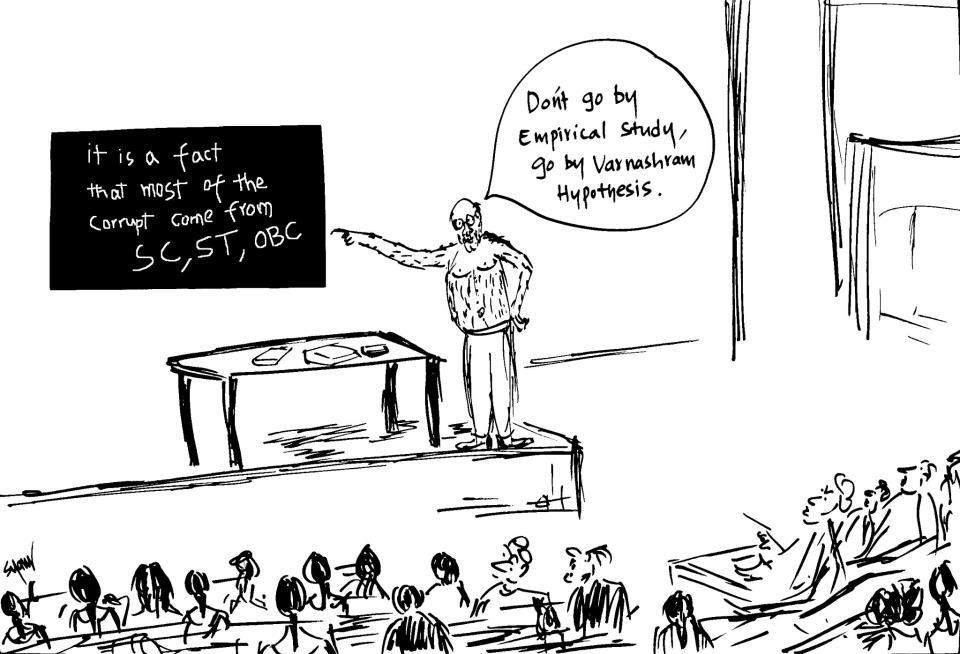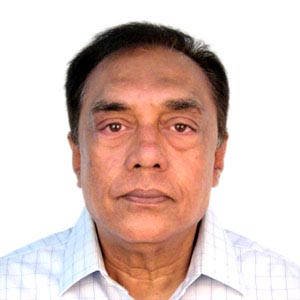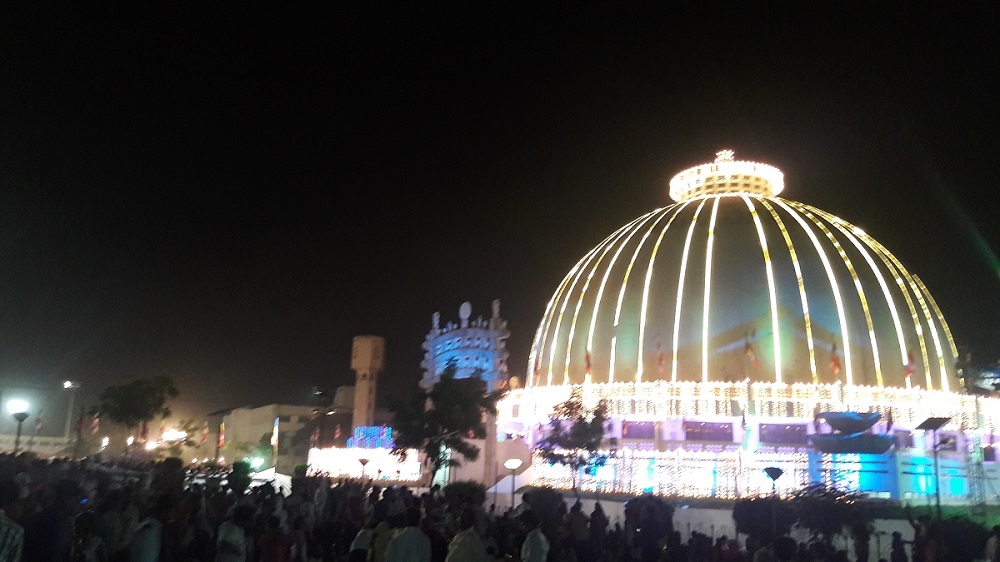Pinak Banik
Continued from Part 1
The purpose of the “Story of Nangeli” appearing on Facebook in Orijit Sen’s own words is:
“This comics story is dedicated to Rohith Vemula (1989-2016), who, like Nangeli, chose death over a life of indignity.“
Tribute to one dead Dalit by presenting another animated Bahujan death!
Neither Rohith nor Nangeli killed himself or herself out of choice but of absence of choice to have a life, in other words they were victims of structural murder. Brahminical oppression is reduced to lack of freedom of choice and individualist romantic zeal of choosing death.
Dead Dalits, as mentioned earlier, are “excellent sites where revolutionary fantasies blossom”! In Sen’s artwork, and in the entire Brahmin historiography and aesthetics, the complete focus is through the microscopic lens placed over victimized bodies, wounds, names and numbers.

Parallels across the Globe
Since I wrote the Part 1 of this essay, another similar act of appropriation of suffering as art, in another part of the world, has unfolded an analogous debate. An American white woman artist, Dana Schutz’s painting “Open Casket,” displayed in the ongoing 2017 Whitney Biennial, has sparked protest from Black artist community for ‘a perceived exploitation of a still-traumatic incident in American history’. The painting is derived from a 1955 press image depicting the body of Emmett Till, a fourteen-year-old African-American boy who was abducted and brutally murdered by white men under a false allegation of whistling at a white woman. An all white jury later acquitted both accused with the false testimony given by Carolyn Bryant, the white woman at the center of the trial. Emmett Till’s mother Mamie Till Mobley had organized his public funeral service with an open casket to show the black community the brutality of her son’s killing, saying, “Let the people see what I’ve seen”. Later she got the photographs of the brutalized body in open casket published in the Jet magazine, a black publication, to ‘speak to and to move a Black audience’, insisting “that the violence that he has been subject to be seen, unobscured”.
Dana Schutz picked one of those photographs (later made into iconic images of the civil rights movement) and painted an abstracted version of the mutilated dead black body in her signature style. Black Scholar Christina Sharpe commented, “It seems to me that what Dana Schutz has done is to take that unobscured violence and make it abstract. Mamie Till wanted to make violence real. And that thing — white supremacy, violent abduction, murder — that Mamie Till wanted to make absolutely clear is abstracted in Schutz’s work, and in her defense of the work.”
The Black artist community has given a call for the removal and destruction of the painting so that it never enters into any market or museum. Berlin based artist Hannah Black has written a letter to the curators and staff of the Whitney biennial, co signed by a group of black artists and scholars. A part of the letter says,
“In brief: the painting should not be acceptable to anyone who cares or pretends to care about Black people because it is not acceptable for a white person to transmute Black suffering into profit and fun, though the practice has been normalized for a long time.”
Now coming to our caste society, immediately after Rohith Vemula’s institutional murder, the mainstream media was flooded with racializing articles with headlines screaming, Dalit minds, dalit suicides and so on, in response to this surge of intrusive and wildly generalizing narratives, all of them focused on the oppressed, many Dalit Bahujan wondered: Why can’t the Brahmin speak from his location as an oppressor? Why are India’s ‘most political’ artists and writers unable to represent the face of oppression?
I had posted this question as a comment on Sen’s Facebook post “The Story of Nangeli”,
“Hi Mr. Orijit Sen, rather than illustrating such obscene pulp fictions around bahujan history, why don’t you illustrate how oppression flows through the individual body and mind of savarnas and handed over from generation to generation, how with the protected essence of oppression change its form/shape/method etc., like how it reaches from breast tax to brahminical obscenities in graphic novels etc….rather than concentrating how Nangeli is remembered by Ezhavas and showing how her breast looked like/how lascivious and desirable she was, do concentrate on your own brethren of oppressors, please portray how their body used to react/still reacts during hardcore and softcore oppression, whether there were bodily evolution among savarnas across generations, since it seems your obsession with body to depict history/identity is enormous. Nangeli’s history is remembered by bahujans and will be remembered, and it’s a part of their everyday struggle to human dignity, at the heart of anti caste movement.”
His immediate response was to label the questions as a “rant” and “Facebook Police PaTroll”, dismissing it outright, as he felt “offended” by the tone of the questions. It seems getting offended is also an exclusive Brahmin Savarna right. Dalit Bahujans are not supposed to feel offended with the obscene delineation of their histories and struggles and shouldn’t question or criticize assertively! Freedom of speech and expression are not sociologically universal categories or natural rights in a caste society, where any freedom is determined from the very vantage point of distinguishing caste locations. In this case, freedom of expression precisely means to defend Brahmin Savarna’s right to seduce, abduct and distort Dalit Bahujans into their own convenient stereotypes.
Sen then posted a longer response to the comment “reconsidering” his “decision”. He says,
“While I completely agree that the fact of upper caste birth confers on me enormous privileges vis-a-vis people from dalit bahujan backgrounds I have not personally attempted to ‘corner’ any cultural capital beyond what I produce as an artist. I cannot undo the fact of my birth, but I can, and do, attempt to bring about a more just and equitable society through my work. That is my motivation for telling Nangeli’s story. If you have an issue with that, I’m afraid you’ll just have to live with it – because i’m going to continue doing whatever I believe is important and right.” (Anyone wanting to read the entire response of Orijit Sen can find it here https://www.facebook.com/pinak.banik/posts/1328579710515086)
What is new in this view of larger Savarna progressive and liberal appetite “to bring about a more just and equitable society” through victimizing Bahujan histories, patronizing fantasies towards Bahujan dead bodies, without ever exposing the mechanisms of oppression that they collectively operate? Sen’s statement “I have not personally attempted to ‘corner’ any cultural capital beyond what I produce as an artist” provides the answer. Brahmin Savarnas think that they operate as individual entities, bodies independent of any social, cultural historical continuity or burden. Thus imagining that they do not contribute to the larger mechanism of oppression currently in place and instead see it as a faceless system of nation state.
Now coming to the structural placement of figures like Sen, or future Sens, occupying all contemporary art studios, independent design interventions, artist collectives, publications, editing endeavors, educational institutions, commissioned projects, art & literature festivals, seminars, art and culture sections of media houses etc, they are ubiquitous and uniformly from the ruling castes and class. Any study will reveal Brahmin Savarnas have been exclusively dominating public organizations, administrative, state funded and autonomous institutions in any field. These are the same spaces where Bahujans only enter as wage labourers, cleaners, cooks, delivery boys, electricians, plumbers etc., or exploited passive participants, plastic materials.
Why are these culturally happening spaces so closed and exclusive? Is it the inherited merit that qualifies only certain sections to be there? One wonders about ethnography of Brahmin Savarna networks that make them so corpulently expansive. Can we have some insightful stories about those ethnographies from Savarna artists like Sen? Perhaps in Harvey Pekar’s autobiographical style or in populist satirical serialized Daniel Clowes/ Robert Crumb/ Spiegelman style of depiction but hopefully devoid of popular LSD automatism of Savarna Artistdom.
We won’t have such stories surfacing, because progressive liberals are unable to trace hegemony in the very spaces they inhabit but locate oppression in their own legitimized binaries far away from their intimate spaces. Orijit Sen opines that Bahujan’s oppression is gone since some of them can read and write English fluently and are comfortable ‘writing on Facebook’! Thus in Sen’s own words they “obviously have access to similar privileges as myself. Hence, to say ‘we are denied entry to your worlds’ is a bit hypocritical.”
In contrast Dana Schutlz’s intention was read by some as dealing with white shame. Savarna shame however does not figure in the depiction of Nangeli or Rohith.
“Although Schutz’s intention may be to present white shame, this shame is not correctly represented as a painting of a dead Black boy by a white artist – those non-Black artists who sincerely wish to highlight the shameful nature of white violence should first of all stop treating Black pain as raw material. The subject matter is not Schutz’s; white free speech and white creative freedom have been founded on the constraint of others, and are not natural rights. The painting must go………“
In protest, artist Parker Bright stood in front of Schutz’s painting wearing a shirt that read “Black Death Spectacle,” blocking the painting from public view for several hours in the biennial. Christina Sharpe articulates this action as, “Wake work” that “Black people do in the face of our ongoing death, and the ways we insist life into the present. I think it’s really powerful that those Black young people put their bodies in front of that painting. For me, that is a wake. Those young Black people are keeping watch with the dead, practicing a kind of care.”
In the same interview Christina Sharpe draws the question of crucial ethics of relationship between intimacy and violence, saying,
“There’s an intimacy that you have as the perpetrator of violence, and an intimacy that you have as people who have suffered violence. An illustration: There’s the intimacy of, let’s say, an enslaved community; then there’s the intimacy of the master, who, when a member of that enslaved community runs off, puts an ad in the paper describing that person in all kinds of detail. That’s an intimacy of violence. So there are at least two intimacies in relation to looking at that painting, which is looking into a casket. Is it the intimacy of the woman who has now said she made the shit up [Carolyn Bryant, Emmett Till’s accuser], or is it the intimacy of Mamie Till? I’m not going to assign an intimacy to the artist. I’m simply saying those are questions one should ask of how one is positioned.”
In the context of Orijit Sen’s graphic depiction of Nangeli, parallel questions have been raised which were not only addressed to an individual artist, but to the entire ruling class.
The enclosed Savarna art and culture empire has normalised this execution of transmuting Dalit Bahujan’s cultural practices, histories of suffering and resistance into “profit and fun” subjects of their leisure.
The suppression of autonomous Dalit Bahujan discourses has enabled them to keep gaining from this heinous cultural political transgression unquestioned. Christina Sharpe response to the demand of destroying Schutz’s painting saying “there can be an ethical call to destroy something” to the interviewer’s question speculating on “destroying any created work feels like burning a book” reminds me of Dr. Ambedkar’s act of burning the atrocious Hindu law book Manusmriti on 25th December, 1927 in Mahad, located in the same spirit of reclaiming human dignity, embracing the values of liberty, equality and fraternity through an assertive and creative process of destruction.
Assigning submissive fantasies to Assertion and Revolutionaries and Claiming right to Obscenities.
In this part, I intend to anatomize two more works circulated on social media. Orijit Sen’s representations only serve here as typical examples to connect the critique with broader phenomenon of such parasitic art practices, from different contexts, time, space and complexity, located within the enclosed world of Savarna Art.
After Rohith Vemula’s state-institutional murder, Orijit Sen had posted an image of Rohith Vemula titled “R-Day” on Facebook on 25th January 2016. It portrays Rohith Vemula with a bleeding heart on his left hand and the right hand is reaching out to a hanging rope and his fist inside the noose. Rohith’s anguished, disillusioned face with a blue background and a superimposed portrait of Dr Ambedkar. The image carries a selective sentence from Rohith’s suicide note. Whoever is aware about the nationwide Savarna (both conservative and liberal) initiated commodification and opportunistic politics over Rohith’s death and his suicide note must know how dozens of articles, essays, reports, and poetry were produced within few weeks of Rohith’s murder, particularly “interpreting” the suicide note. All such interventions try to construct a fictional abstraction of Rohith, as a harmless, timid, generous, amicable and glorified soul who just attained nirvana by choosing death over a life of pain and discrimination to teach humanity a lesson. Nidhin Shobhana in his essay “Brahmin-Savarna opportunities in a Dalit Death” has brilliantly analyzed this process of mystification of Rohith by making a ‘Saint’ out of a Political Opponent, Brahmin-Savarna’s dismissal of ‘numbers’ and making of Rohith’s heroic individualism at the cost of his community in details.
Why is he holding a bleeding heart? How can that be a symbol of the magnitude of oppression and anguish that a community, from where Rohith come, and has been made to go through? Does the millennium old the oppression of certain communities make them pure, innocent and ’emotionally injured’? And what ethical right has Orijit Sen got to articulate their anguish?
Rohith wrote “I loved Science, stars, nature but I loved people without knowing that people have long since divorced from nature…”, (the same sentence used on Sen’s image), one wonders, why do Brahmin Savarna of all hues and shades, love to interpret this sentence so much? Because, this one sentence gives them good opportunity to decontextualize Rohith. There is no reference in the image which can suggest the determinants that composed Rohith’s struggle and politics, his community, his family, his fight for education, his resistance within the campus and other real life spaces, and more importantly the kind of people and their structural violence that was part of his everyday life, like many other Dalit Bahujan student in Brahminical educational spaces. Even, given the limitations of all these in a single image, not a single perspective is there, rather the sole purpose of the image itself seems to construct Rohtih (like Nangeli) as an isolated individual hero, disillusioned, submissive to his pain, whose only glory is in choosing romanticized death. An alive Rohith never deserved an artwork or at least a mainstream media report of events during his suspension cum social boycott in HCU, but a dead Rohith got it all.
Moreover in the image we have a charming starry blue-sky backdrop with Dr Ambedkar’s portrait. To me this looks like harsh insensitive image making. An anguished face of Rohith and a silent Dr. Ambedkar, looking outside the frame in the background. If we compare this image with another Brahmin pictorial commodity on Bahujan struggle, Anand Patwardhan’s poster for his documentary “Jai Bhim Comrade”, where we again have another dead Dalit, Shahir Vilas Ghogre on the poster with an imposition of a red cloth tied around his waist to suggest his ‘solidarity’ within Savarna led Marxist politics.
This appropriation system also hand picks those few Bahujan artists who emerged within these enclosed art empires, either to distort their dedicated practice deeply located within Bahujan values or to tame their existence with mythical readings of their work. One such recent attempt was Vivan Sundaram’s 2015 project cum exhibition, in collaboration with former National School of Drama director Anuradha Kapur and others, called “409 Ramkinkars” at the Indira Gandhi National Centre for the Arts (IGNCA), Delhi telling the stories of life and works of an artist-sculptor-painter-performer, Ramkinkar Baij (1906-1980) reconceptualized in an Urban industrial, some kind of futuristic context. In a presentation with Imasi Foundation, Vivan claims his inspiration for the “re-take” of Ramkinkar comes from an artistic affinity with Ramkinkar. Vivan had earlier reconceptualized his aunt, artist Amrita Shergil (1913-1941) from her father Umrao Sher-Gil’s photographs, in 2001, which he again claims came from the artistic affinity) (https://vimeo.com/205084440)
The question is, on what principles does his affinity frame this process of curation, of certain aesthetics in one upper caste artist (Sher-Gil) in relation, coming from aristocratic plus a distinguished diaspora upbringing, her well preserved, almost a century old photographic archive and simultaneously another Bahujan artist (Ramkinkar) coming from the Adivasi Bahujan that populated north western Bengal with a practice deeply rooted in Bahujan productive traditions. Since affinity is a construction of the socio-cultural material factors that nurture one’s sense of judgment, install cultural values and worldviews in particular socio-cultural circumstances, what does affinity mean in this case? Is artistic affinity different and has to be discounted on the grounds of artistic freedom of indulgence? Answers to these questions call for another essay, along with deconstructing the politics behind Vivan’s “re-take” of Ramkinkar and mushrooming mythical theorizations on Ramkinakar by Savarna artists and historians. In these cases, the collaborative network of savarna artist, curator, educators, state non-state gallery/cultural institution systems, art critics’ and publishers’ work smoothly with received unity and gentle support by participation of the rest of art fraternity, skillfully leveraging a larger viewership.
Apart from that, most importantly, serious study of Ramkinkar’s life and works has to be undertaken. Ramkinkar has been a pioneering artist who assimilates Bahujan values, sensibilities and responsibilities with new schemes of knowledge, a parallel to the phenomenon of emergence of Bahujan modernity, affirmation and self-determination. In fact, he was the only instrumental figure of his time behind liberating the very idea and idioms of artistic practice, process, relations and traditions, from which many of his students in Shantiniketan and later artists across the country have largely benefited. Ramkinkar is now a cultural capital for many Savarna artists and writers. Ramkinkar needs to be reclaimed and brought into our own intimate discussions.
Another important Bahujan artist from rural Telangana, T. Vaikuntam (born 1942), whose practice is entrenched in the local rural artisanal creative materialist values and concerns, is being constantly misconstrued by Savarna art writers. Rich assertive aesthetics in his works are being largely unacknowledged by mere pictorial analysis without sociologically locating his nearly 5 decades of practice! Vaikuntam is one of those artists, who unlike Savarna celebrity artists, are not renowned or referred to in artistic spaces beyond their own geographical regions, their works not well documented and erroneously reviewed. But in Telangana, Vaikuntam as an artist figure is largely celebrated by the Dalit Bahujans and there is a rich interpretation of his works among them. Art circles and institutions in Hyderabad too revere Vaikuntam’s artistic caliber. Vaikuntam’s artworks have also received broad economic success in it’s own kind of market, but no competent theorized reading of his practice has been yet appeared in art writing. Works from artists like Vaikuntam doesn’t fit into the dominant tradition modern binaries, nationalistic avant-garde frameworks or within the Savarna disorientation of local-global-urban. It is very evident that Savarna art historians and critiques are unable to recognize aesthetics in Bahujan artists. On contrary to Bahujan artists, these historian and writers are legacies of communities, historically detached from the measures of labour and production. Vaikuntam’s vast body of work needs to be studied from a Dalit Bahujan epistemological standpoint and we hope to do that soon in future. The treasure within his artistic investment can be a guiding light of a successful regional Bahujan aesthetics of our time and illuminating substance inspiring Bahujan artists across the subcontinent.
We need to work towards building a Dalit Bahujan artist cultural activist fraternity in the same spirit to decolonize Dalit Bahujan cultural historical heritage, ideogram and epistemology. As we envision building our own self sustained platforms and institutions in coming days, there will be an entire regime of abuse, derision and threat, actively out there to manipulate and prevent formation of oppressed’s own united cultural spaces, critical articulations, collective assertions similar to what artist Hannah Black, writer of the protest letter to the Whitney biennial faces, “derided by many white and white-affiliated critics as trivial and naïve”. But as a historical process such initiatives, individual and collective have emerged and will continue to emerge from Dalit Bahujans at large, which need guidance and care from already established Dalit Bahujan fraternities.
~~~
Pinak Banik is a visual artist and independent researcher from West Bengal. His areas of interest are Socio cultural Historiography, Political economy, Anthropology, Art and Society. He can be reached at imrealartist@gmail.com
Image by Pinak Banik.










